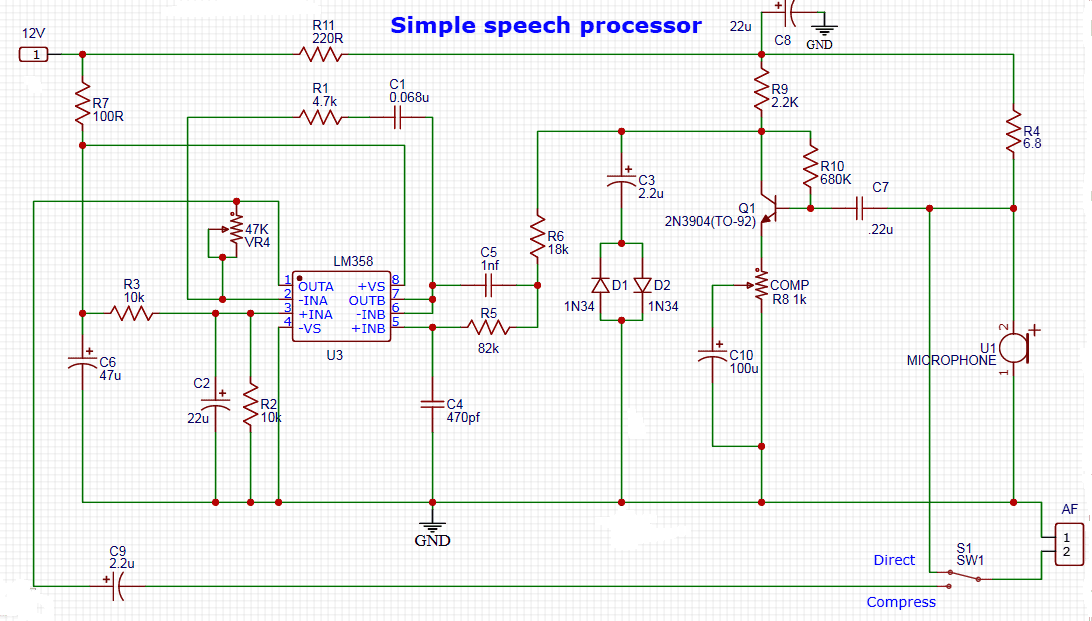A speech processor is an essential component in amateur radio and audio systems that enhances voice clarity and intelligibility. This comprehensive guide will walk you through building a simple yet effective simple speech processor circuit using the LM358 operational amplifier and discrete components.
A speech processor is an electronic device that modifies audio signals to improve their transmission characteristics. It typically includes compression, filtering, and amplification stages to ensure optimal voice clarity in communication systems, particularly in amateur radio applications. In this post, we’ll explore a simple speech processor circuit based on the LM358 dual op-amp IC, designed for easy construction and efficient audio compression.

Simple Speech Processor – Main Components Required
- LM358 Dual Op-Amp (U3) – The heart of the circuit providing amplification and processing
- 2N3904 NPN Transistor (Q1) – Output driver stage
- 1N34 Germanium Diodes (D1, D2) – For compression and signal rectification
- Various resistors and capacitors – For biasing, filtering, and coupling
Simple Speech Processor – How the Circuit Works
Input Stage
The microphone signal enters through the input connector and passes through a coupling network. The LM358 op-amp (U3) provides the initial amplification with adjustable gain controlled by VR4 (47kΩ potentiometer). VR4 (47k Potentiometer) acts as a gain control, allowing you to adjust the input sensitivity and thus the overall amplification of the microphone signal.
Compression Stage
This is where the magic happens for dynamic range control. The amplified signal from the LM358 (Pin 7) is fed through R5 (82k) to the compression stage. Transistor Q1 (2N3904) and its associated resistors (R6, R9, R10) form a key part of the compressor. The transistor acts as a variable resistance, controlled by the audio signal itself. As the signal gets louder, the transistor biases differently, reducing the gain to “compress” the signal.
Diodes D1 and D2 (1N34) are germanium diodes, known for their low forward voltage drop. They are connected in anti-parallel and act as a soft limiter or clipper. When the audio signal exceeds a certain voltage (determined by the diodes’ forward voltage), they start to conduct, effectively “clipping” the peaks of the waveform and preventing overmodulation. C10 (100uF) likely helps in the attack/release characteristics of the compression. Germanium diodes are chosen for their lower forward voltage drop compared to silicon diodes, allowing for more subtle clipping at lower signal levels, which is often desirable in audio applications.
Output Stage
The 2N3904 transistor (Q1) serves as the output driver, providing sufficient current to drive the next stage in your audio chain. SW1 (Single Pole Double Throw) allows you to select between the “Direct” (unprocessed) signal from the microphone (via R4 – 6.8k) and the “Compress” (processed) signal. The selected audio then goes to the “AF” (Audio Frequency) output, ready to be fed into an amplifier, transmitter, or recording device.
Circuit Analysis
Resistors R1 (4.7kΩ) and R2 (10kΩ) create a voltage reference for the op-amp, ensuring proper DC biasing. Capacitors C2 (220nF), C5 (1nF), and C7 (22µF) determine the frequency response of the circuit, optimized for speech frequencies (300Hz – 3kHz). The compression characteristics are determined by the diode network and associated components R6 (18kΩ) and C3 (2.2µF).
Simple Speech Processor – Key Features
- Adjustable Compression: Fine-tune the compression ratio for different voice characteristics
- Bypass Option: Switch between processed and direct audio
- Low Noise: Careful component selection minimizes background noise
- Simple Design: Uses readily available components for easy construction
The combination of the LM358 op-amp and discrete components creates a versatile speech processing solution that can be easily modified and enhanced based on specific requirements. Whether you’re building it for learning purposes or practical application, this circuit offers a solid foundation for understanding speech processing principles.
Microphone Audio Compressor Circuits: Essential Tools for Amateur Radio and Audio Applications
